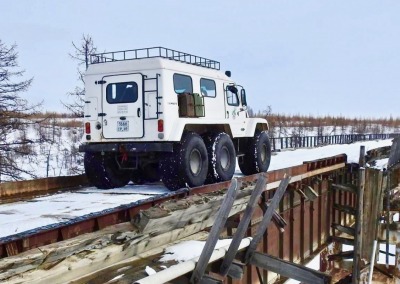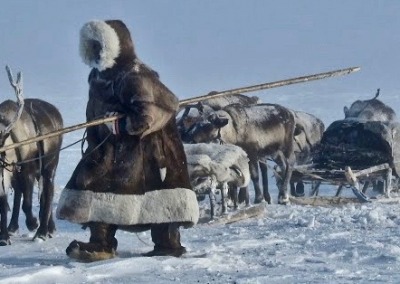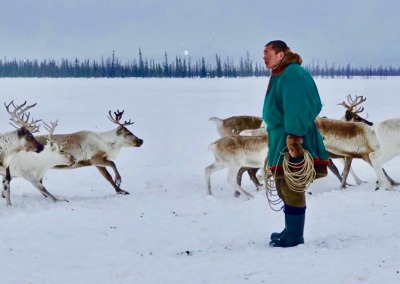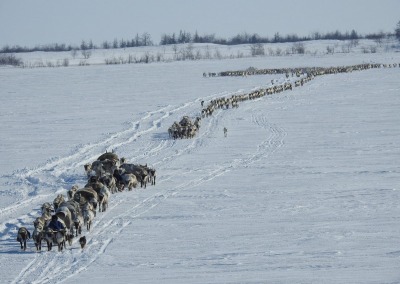Winter
December: There are about 5 daylight hours at the beginning and end of December and around 4 in the middle. Weather is mostly fairly dark and overcast with very regular blizzards. As most Nenets camps are still located on the treeless Yamal Peninsula tundra, this is probably the coldest month to visit. Air temperatures in January are colder on average, but the Nenets are already in the forest tundra, so the howling tundra wind is a thing of the past.
Some photographers find these conditions too difficult to shoot in. Others prefer this time of year, as they feel it gives their pictures the harsh Arctic winter look they want. It is certainly the best time of year to get a feel for the incredible harshness of the Nenets way of life and to express this with your photography.
Weather aside, in our opinion December is one of the best times to visit. Most Nenets groups are migrating 2 – 4 times a week, so you are almost sure to partake in these epic events. Northern Lights are becoming a more regular event. It is so cold that many people wear the full range of traditional clothing. As explained on our Traditional Clothing page, Nenets have several items of traditional fur clothing and only wear all of them in the most extreme temperatures.
More than anything else, December (like November) is good because the Nenets are still in the treeless tundra of the Yamal Peninsula. It is an utterly barren and other-worldly landscape, and you can really see where Yamal, which means “the edge of the world” in the Nenets language, gets its name from. In January the Nenets have moved off the Yamal Peninsula and into the forest tundra, where they will remain until April. The forest tundra is beautiful in its own right, but for most people will be a much more ordinary-looking landscape than the real Arctic tundra.
The tundra itself is very beautiful in December too. It is smoothed by the wind, so reflects all the colours of the sunset. The wind also sculpts it into beautiful structures like sastrugi. In April, the next time when the Nenets move back onto the Yamal Peninsula, the snow is already soft and wet and does not look so beautiful.
Most Nenets camps are located not far from a village or town at this time, so people are once again able to visit shops, family and friends.
Most Yar-Sale Nenets also do the crossing of the Gulf of Ob at this time. The Gulf of Ob is a bay of the Arctic Ocean between 40km and 100km wide. It divides the Yamal Peninsula from Nadym District of the Yamal-Nenets Autonomous Region. The crossing takes up to 24 hours and has to be done in one go, as of course there is no food for the reindeer out on the ice. Several reindeer are lost every time they do the crossing. Once on the other side, the Nenets are already in the forest tundra. The December crossing, in temperatures that often hit -45°C and with a wind howling down the Gulf of Ob straight from the North Pole, is the stuff nightmares are made of. If guests want to accompany the Nenets on this crossing we always recommend hiring an all-terrain vehicle so that you have somewhere to warm up. The northward
crossing when they return to the Yamal Peninsula in April is much more pleasant.
January: Most Yar-Sale Nenets groups reach their winter pastures at some point in January. They set up their chums and stop migrating for two to three months, or do one or two very small migrations at most. These winter camps are anything from 150km to 200km south or southeast of Yar-Sale village. This is in an area with many well-preserved gulag camps, which guests at this time will have the opportunity to explore.
The way that the Nenets herd the reindeer changes at this time. During the rest of the year, while migrating, they herd the reindeer in a linear fashion in the same direction as the migration. When they reach a new campsite they leave the herd several kilometres behind. Over a couple of days the herd catches up with the camp, passes it and continues onwards for a few kilometres. The whole camp then migrates and overtakes the herd again.
In winter the herd is kept much further away from the camp at a distance of anything from 15km to 35km. The herders go out to the herd every second day to round it up and move it on to a new pasture area. They gradually move the herd in a vast circle, radius 15km – 35km, around the site of the encampment over the whole period while they are camped in one place.
Although temperatures are cold, there is little wind thanks to the protection provided by the forest. Days can be quite sunny. This, combined with the lack of migration and the comparative lack of herding work, makes this by far the easiest and most relaxed time of year for the Nenets. People use this time to make new sledges, to sew new fur clothing and chum covers and to visit friends and relatives.
There are about five hours of daylight at the beginning of the month and eight hours at the end.
For those who want to partake in migrations and be busy all day every day, this may not be the best time to visit.
February: Early February is usually as cold as January, with temperatures of -45°C seen for a few days most years. Daylight hours are getting significantly longer though, with eight hours at the beginning of the month and eleven hours at the end.
Herding work and activities are again much as described above for January. It is not a very active time of year. Guests will spend more time around camp than usual, but will get to go out and herd the reindeer several times a week.
There are several advantages to visiting at this time of year, however. One is that it is very good for Northern Lights, especially if you come at the time of the New Moon. Another is that you will get to visit gulag camps. A third is that it is more of a relaxed trip than you would have at a migratory time of year. You will spend much less time outdoors freezing on bumpy, cramped sledges. It is less extreme, less harrowing and better for people who want a more comfortable trip than you would have in November or December.
December: There are about 5 daylight hours at the beginning and end of December and around 4 in the middle. Weather is mostly fairly dark and overcast with very regular blizzards. As most Nenets camps are still located on the treeless Yamal Peninsula tundra, this is probably the coldest month to visit. Air temperatures in January are colder on average, but the Nenets are already in the forest tundra, so the howling tundra wind is a thing of the past.
Some photographers find these conditions too difficult to shoot in. Others prefer this time of year, as they feel it gives their pictures the harsh Arctic winter look they want. It is certainly the best time of year to get a feel for the incredible harshness of the Nenets way of life and to express this with your photography.
Weather aside, in our opinion December is one of the best times to visit. Most Nenets groups are migrating 2 – 4 times a week, so you are almost sure to partake in these epic events. Northern Lights are becoming a more regular event. It is so cold that many people wear the full range of traditional clothing. As explained on our Traditional Clothing page, Nenets have several items of traditional fur clothing and only wear all of them in the most extreme temperatures.
More than anything else, December (like November) is good because the Nenets are still in the treeless tundra of the Yamal Peninsula. It is an utterly barren and other-worldly landscape, and you can really see where Yamal, which means “the edge of the world” in the Nenets language, gets its name from. In January the Nenets have moved off the Yamal Peninsula and into the forest tundra, where they will remain until April. The forest tundra is beautiful in its own right, but for most people will be a much more ordinary-looking landscape than the real Arctic tundra.
The tundra itself is very beautiful in December too. It is smoothed by the wind, so reflects all the colours of the sunset. The wind also sculpts it into beautiful structures like sastrugi. In April, the next time when the Nenets move back onto the Yamal Peninsula, the snow is already soft and wet and does not look so beautiful.
Most Nenets camps are located not far from a village or town at this time, so people are once again able to visit shops, family and friends.
Most Yar-Sale Nenets also do the crossing of the Gulf of Ob at this time. The Gulf of Ob is a bay of the Arctic Ocean between 40km and 100km wide. It divides the Yamal Peninsula from Nadym District of the Yamal-Nenets Autonomous Region. The crossing takes up to 24 hours and has to be done in one go, as of course there is no food for the reindeer out on the ice. Several reindeer are lost every time they do the crossing. Once on the other side, the Nenets are already in the forest tundra. The December crossing, in temperatures that often hit -45°C and with a wind howling down the Gulf of Ob straight from the North Pole, is the stuff nightmares are made of. If guests want to accompany the Nenets on this crossing we always recommend hiring an all-terrain vehicle so that you have somewhere to warm up. The northward crossing when they return to the Yamal Peninsula in April is much more pleasant.
January: Most Yar-Sale Nenets groups reach their winter pastures at some point in January. They set up their chums and stop migrating for two to three months, or do one or two very small migrations at most. These winter camps are anything from 150km to 200km south or southeast of Yar-Sale village. This is in an area with many well-preserved gulag camps, which guests at this time will have the opportunity to explore.
The way that the Nenets herd the reindeer changes at this time. During the rest of the year, while migrating, they herd the reindeer in a linear fashion in the same direction as the migration. When they reach a new campsite they leave the herd several kilometres behind. Over a couple of days the herd catches up with the camp, passes it and continues onwards for a few kilometres. The whole camp then migrates and overtakes the herd again.
In winter the herd is kept much further away from the camp at a distance of anything from 15km to 35km. The herders go out to the herd every second day to round it up and move it on to a new pasture area. They gradually move the herd in a vast circle, radius 15km – 35km, around the site of the encampment over the whole period while they are camped in one place.
Although temperatures are cold, there is little wind thanks to the protection provided by the forest. Days can be quite sunny. This, combined with the lack of migration and the comparative lack of herding work, makes this by far the easiest and most relaxed time of year for the Nenets. People use this time to make new sledges, to sew new fur clothing and chum covers and to visit friends and relatives.
There are about five hours of daylight at the beginning of the month and eight hours at the end.
For those who want to partake in migrations and be busy all day every day, this may not be the best time to visit.
February: Early February is usually as cold as January, with temperatures of -45°C seen for a few days most years. Daylight hours are getting significantly longer though, with eight hours at the beginning of the month and eleven hours at the end.
Herding work and activities are again much as described above for January. It is not a very active time of year. Guests will spend more time around camp than usual, but will get to go out and herd the reindeer several times a week.
There are several advantages to visiting at this time of year, however. One is that it is very good for Northern Lights, especially if you come at the time of the New Moon. Another is that you will get to visit gulag camps. A third is that it is more of a relaxed trip than you would have at a migratory time of year. You will spend much less time outdoors freezing on bumpy, cramped sledges. It is less extreme, less harrowing and better for people who want a more comfortable trip than you would have in November or December.




